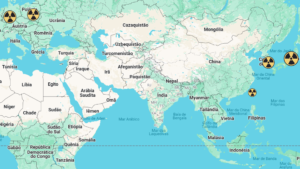- Th new plane was announced by the US military as an evolution of the B-2;
- Several improvements, in addition to state-of-the-art technology, arrive with the new plane;
- The much anticipated announcement of the B-21 reinforces the aspect of the United States wanting to keep their position as a geopolitical leader.
The United States is always testing, creating, and evolving its weapons systems or military in general, but in today’s scenario and geopolitical context, achieving a powerful new way to use nuclear weapons may contain subjective messages for other nations.
The B-21 Raider, successor to the B-2, has important evolutions and seems to be the new bet in the nuclear strategy of the American military power.
With significant changes in the model known for its great stealth to radars, the B-21 can help in the modernization of the “nuclear triad” of the United States, one of the countries that uses this strategy in the most consistent way in the world.

What is a strategic bomber and its role Nuclear triad
Since wars have existed and war equipment has started to be built, military strategies have evolved to accompany such development.
Bombing is one of these strategies and makes up one of the pillars of the Nuclear Triad strategy. With large-capacity weapons, it is possible to impose deterrence, demonstrate its State power or completely destroy its enemy, bringing a tragic end to war, as in World War II, when the United States dropped atomic bombs on Hiroshima and Nagasaki, inferior to the power of destruction than a nuclear bomb would now.
Having such powerful weapons, countries need consistent nuclear strategies and one of them, the most famous and coherent, is the “Nuclear Triad.” As much as several countries like China, India, France and Russia have weapons and organizations based on this strategy, the United States triad is one of the most consolidated and lasting.
With this strategy, countries manage to launch nuclear weapons against the enemy via air, land or sea, using 3 of the main military domains. In this way, the resilience of a country’s nuclear attack capacity is increased, because if one of the attack methods becomes inoperative or is eliminated, there will be other alternatives.
The Nuclear Triad is structured as follows:
- Strategic Bombers: Airplanes that carry missiles or bombs for nuclear or conventional attacks. They are fast and make up the first part of the triad. There are several categories and strategies for bombing, but the most common is its use as a warning or threat to end the war by ending your enemy’s ability to continue;
- Land Launch Missiles (Intercontinental Ballistic Missiles): As the second component of the triad are the missiles, which fall directly on the target and are transported by specialized vehicles or are permanently housed in nuclear silos. They hit the target faster and more controlled. In addition, it is possible to know exactly who is the country carrying out the attack and who is the target. However, they cannot be used as a threat, because once launched, these missiles cannot be deactivated;
- Ballistic Missile Launch Submarines: They are missiles like the previous ones, but launched by specialized submarines for this type of task. A large part of nuclear submarines are destined for this purpose, being very important for the great powers since the Cold War period. Only five countries operate this type of submarine: China, France, England, United States and Russia.
The main features in the new American Nuclear B-21 strategic stealth bomber and its differences from the old B-2
Stealth is a key feature that sets the B-2 apart from other bombers around the world. It has technologies capable of making it difficult for radars to access and detect its location, making it easier to attack targets.
In addition to its key stealth, the B-2 can also fly for six thousand miles without needing fuel and hit targets accurately. However, as it was created during the Cold War and delivered shortly after the fall of the Soviet Union, the technology of these aircraft is already outdated, resulting in some accidents that bring significant budgetary losses to the American air forces, considering that their value of manufacturing is $2.2 billion per unit.
This is where the need for the United States to invest in a new and updated version of the B-2, the new American aircraft B-21, arises. The design of both are similar, both resemble a wing, stealth and stealth are also maintained, but strategic and technology changes are highlights.
The B-21 represents the modernization of the US nuclear triad’s air option, capable of carrying intercontinental ballistic missiles (ICBMs). In addition, the relatively outdated American air fleet gets a renewal after the government completes its desire to order 100 units of this new model.
Some of the highlights of the B-21 over the B-2 are:
- Economy: With the B-2 costing US$2.2 billion to manufacture and over one hundred thousand dollars to operate, in addition to outdated technological systems, economy is one of the highlights of the new model.
On the other hand, the B-21 will cost just under $700 million per unit. Another savings will come from the data collected by the B-21, which will be stored in a cloud, thus also reducing infrastructure costs;
- Modernity: Modernity reinforces the country’s global strength to the geopolitical scenario, in addition to bringing several benefits, such as;
- Easy Maintenance: The work of engineers becomes simpler with new parts, renewed design and modern systems, because the older the components of the aircraft, the more complex this work is;
- Ease of System Update: Built from today’s strong and smart technologies, it will be easier to update a system that won’t get outdated quickly;
- Eventually being able to be used without a crew: Making high-risk missions easier and avoiding failures that may occur as a result of human errors, such as in military drones.
In addition, data, weapons and sensors will be interconnected in the new B-21, which seems to be the new bet for a functional fleet. It will also be able to carry both nuclear and conventional weapons.
The plane also has a global reach. It is also designed with a view to potential future upgrades, making this process easier and preventing the B-21 from becoming outdated so quickly as technologies evolve faster and faster.
“The B-21 is the future of deterrence.”
– Northrop Grumman
The importance of launching the new B-21 strategic bomber as a message to Russia and China at a time of tension with Ukraine
With the United States testing its new and powerful B-21, a strategic weapon that is able to provide great nuclear and conventional superiority, this is almost a symbolic response or warning to other countries to show that the United States is still the greatest war power in the world. today’s world and who does not intend to abandon his post as geopolitical leader anytime soon.
Even if the plane is not yet in operation, with its initial details released in early December 2022, the country is already imposing itself again in advance.
On the other hand, Russia and China still want to take the hegemony and concentration of power out of the hands of the Americans, constantly evolving their nuclear weapons. However, with this new announcement the United States tries to subliminally show how its technology is far ahead of the weapons of the other two countries.
In the end, in addition to the economy and the other advantages pointed out in relation to the new weapon, it is the message and the geopolitical symbolism, a decisive factor when countries make their strategic decisions.










Be First to Comment